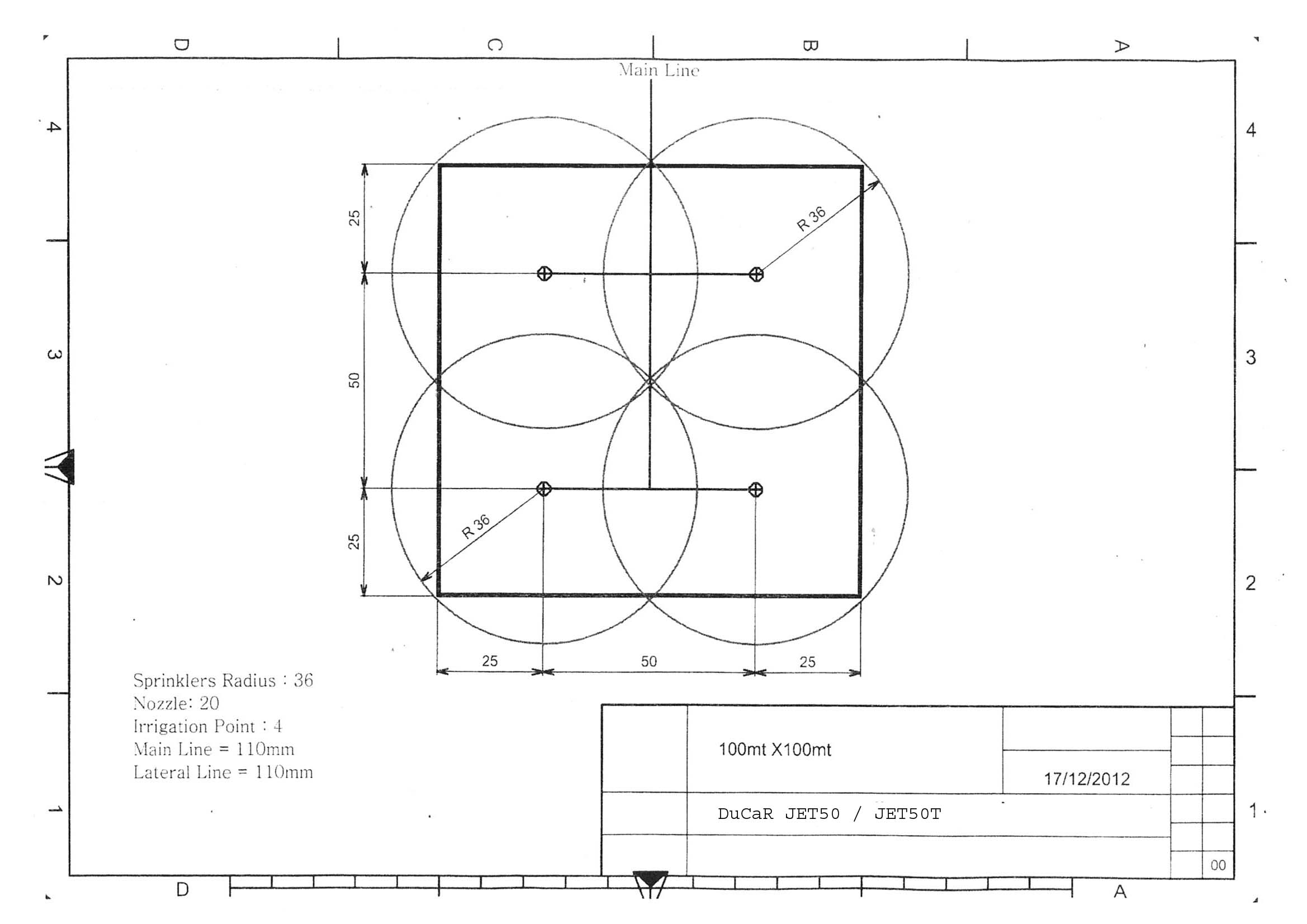Spraying water at a certain angle and pressure, and then letting it fall by its own weight in tiny droplets on the soil and product is called “Sprinkler Irrigation”. This method is called sprinkler irrigation, because the water looks like the natural rain. Sprinkle irrigation can be used in any soil condition, on slopes, flat lands, and almost on any types of plants conveniently. Water with a lower flow rate in comparison to the flow rate surface irrigation requires can be used. Water is sprayed through the nozzles at a certain pressure and released to the atmosphere just like it rains normally. Water, dropped on the ground penetrates into the soil and accumulated around the root of the plant. In sprinkler irrigation, water comes to the nozzles at a certain pressure, and falls on the ground as an artificial rain.
A water installation consisted of a main pipe and lateral lines and a water pump generating the necessary pressure are required for using this method. The pressure is usually generated by a pump unit. Self-pressurized systems called closed circuit are available in some regions. Sprinkler heads identify the system. There are different types of sprinkler heads, depending on the plant, soil, and financial issues.
Sprinkler irrigation systems need less irrigation water than surface irrigation systems,if they are operated properly. They are more useful especially on rough lands with slopes, and higher penetration rates for irrigating plants with shallow roots.
Sprinkler irrigation method requires a certain amount of initial investment and energy costs. Sprinkler irrigation systems will develop, if using this method provides an increase in the number of agricultural products that compensates such costs. Sprinkler irrigation methods are widely preferred, where labor is expensive, because they require less labor.
Portable Systems
Pump unit, main pipe and laterals are portable in this system.
Semi Portable Systems
Pump unit and main pipeline are fixed, and laterals are portable in this system.
Non-portable (Fixed) Systems
Pump, main pipe, and laterals are fixed in this system.
Sprinkler irrigation methods are widely preferred, where labor is expensive, because they require less labor. Semi-portable and fully fixed systems are preferred more and more in nowadays, because labor costs are constantly increasing.
Main components such as pipelines, and sprinkler heads of sprinkler irrigation systems have been significantly changed recently. The cost has been lowered, and the system has become practical thus, their use is generalized. Sprinkler heads are of greatest importance in sprinkler irrigation system. High capacity sprinkler heads (Big Guns) with high wetting capacity are widely preferred. These are very good at medium and high operating pressures. Low pressure applications may damage delicate plants. Nozzle diameters of medium size sprinkler heads are ranged between 8 to 12mm, and their wetting diameters between 15 to 25 mm. Such heads are widely used in the irrigation of field crops, vegetable gardens and orchards. Nozzle diameters of large size sprinkler heads can be ranged between 12 to 28mm, and wetting diameter between 25 to 55mm. Such heads are mainly used in the irrigation of field crops by medium and large sized enterprises.
Operating pressure is the pressure required at the nozzle. Losses due to leakage and friction can be controlled by calculating the pressure differences between the manometers at the pump outlet and the distant sprinkler head. Valves can be installed at the beginnings of lateral pipelines, in systems the main pipelines, of which are embedded in the ground. In addition to these, connection pieces such as T, bend, reduction, and pipe stopper are also used. Saving energy or using more sprinkler heads with the same energy is possible by using pipes with the largest possible diameters, minimizing friction loss.
The information needed for designing sprinkler irrigation projects:
Advantages of Sprinkler Irrigation
Disadvantages:
Commercial fertilizers can be carried by water delivered to plants by sprinkler irrigation. Delivering fertilizers carried by irrigation water to soil provides various advantages.
Including:
Commercial fertilizers can be carried by water delivered to plants by sprinkler irrigation.
Irrigation continues after the fertilizers have been ejected, thus the fertilizers are washed away from pipes and heads. Fertilizer solutions accumulated on leaves are also washed off.
Although pump requirements vary depending on desired shooting range, flow rate and environmental effects, we would suggest following horsepower for our three different sizes of irrigation sprinklers.
For detailed FREE irrigation design, you can submit your land's properties such as dimensions, distance from the water source and other environmental factors.
We would suggest you to use DucaR JET50 or JET70 as the most suitable sprinkler types. In this case, we will design our irrigation solution based on 4 DuCaR JET50 as shown below.

If you wish to irrigate the whole land at a time, then four of the sprinklers have to be run simultaneously on a pipe line with minimum 110m radius. However if you do not have enough water pressure, you may choose partial irrigation.
In this method, you will need to use our four 4-legged stands coming with quick coupling. Yet the required total number of sprinklers can be reduced from 4 to 2 and you can reduce your cost! DuCaR 4 legged stands with quick coupling, makes installing the sprinkler head so easy and quick. However all the stands have to be connected to the pipe line with a valve, so you can irrigate half of the land for desired time by switching off the valves of those two stands. The sprinkler heads can easily and quickly be moved to the other two stands. Then by switching on the valves of those stands, the other half of the land is irrigated with no extra cost!